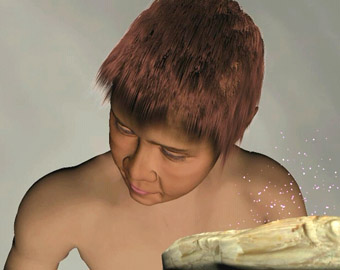animating dreaming into action
danni zuvela: big eye aboriginal animation from canada & australia

The Boy Who Had the Magic Word and the Whispering Moth
AUSTRALIA AND CANADA WERE ESTABLISHED AS COLONIES WHOSE FOUNDING FORCIBLY OCCUPIED TERRITORIES THAT HAD BELONGED TO ABORIGINAL PEOPLES FOR THOUSANDS OF YEARS (40,000 IN THE CASE OF AUSTRALIA AND 12,000 IN CANADA). BOTH INDIGENOUS CULTURES SHARE A MUTUAL SPIRITUAL UNDERSTANDING OF TOTEMIC CONNECTIONS AND COLLECTIVE CONSCIOUSNESS, AS WELL AS BEING THE ONLY TWO FIRST NATION PEOPLES TO REFER TO THEMSELVES AS ABORIGINAL. THROUGH THE LENS OF ANIMATION, BIG EYE: ABORIGINAL ANIMATION FROM AUSTRALIA AND CANADA EXPLORES THE MANY SIGNIFICANT CORRESPONDENCES BETWEEN THE FIRST NATIONS PEOPLES OF THESE TWO COUNTRIES.
Curators Jenny Fraser and Lubi Thomas, together with assistant curators Rennae Hopkins and Maggie McDade, have produced a resonant and imaginative study of recent creative work by Aboriginal artists and filmmakers from Australia and Canada. Staged over an array of screens throughout QUT’s versatile multimedia space, The Block, the show is more than a survey. It also included a popular interactive component, where participants create short moving animations in Flash in a permanently set up drop-in lab. Crucially, the curators’ thoughtful selections and presentation establish an international, interdisciplinary dialogue between Australian and Canadian animation.
Animation is naturally a hybrid medium, as Big Eye’s inclusion of claymation, CGI and machinima, and traditional line-drawn 2D styles shows. However, the focus on this stubbornly heterogeneous field carries a political charge as well. In Australia, unlike Canada, creative work in the moving image is conspicuously canalised into the very different worlds of filmmaking and (new) media arts. As self-described ‘digital native’ Jenny Fraser notes in the exhibition’s floornotes, “(a)pparently the two entities shall never meet, and sadly the Aboriginal sub-sections of those industries have followed suit. However, in other countries, like Canada, the arts world is bighearted enough to embrace and support both, simultaneously. On a curatorial level, animation was chosen as a screen-based genre that crosses that divide with ease, along with the other divides, like age, education and socio-economic status.”
Border-crossing is addressed in Australian Aboriginal artist Aroha Groves’ use of Second Life in her work, What is a Blakfulla doing in a virtual realm? Her sexy, pistol-wielding machinima transcends the limitations imposed by time and place in the creation of a provocative online Aboriginal character. Fusing contemporary and historical pop cultural motifs with hints of menace tempered with absurdism, Groves’ work clearly delights in the potential for experiment and play with identity afforded by art-making in the digital realm. This work, like Canadian Skawennati Tricia Fragnito’s TimetravellerTM (2008), employs digital animation tools to question the role of representation in the fantasy of online personae and suggests some emancipatory possibilities of cyberspace for Aboriginal people.
The limitless worlds of plasticine animation are explored in Orphan Boy (2004) by the Gunbalanya Community and Gozer Media, from Western Arnhem Land. This communally-authored piece, together with sister story The Echidna and the Turtle (2003), makes expressive and dynamic use of plasticine to relate key dreaming stories. Orphan Boy’s carefully composed soundscape contrasts with the deliberately rough-hewn visuals, just as the sticky, fingerprinted faces are complemented by brilliant cobalt and magenta sparkles signalling the Rainbow Serpent’s magic. The boldness of the forms and dramatic flair with which this dreaming is related are engrossing—the film completely captured this spectator. While the Canadian claymation counterpart, Dennis and Melanie Jackson’s Wapos Bay Series (2009), utilises a much more ‘licked finish’ to depict the life of a fictitious community in northern Saskatchewan, its primary appeal is also the charming way in which the clay characters, sets and mise-en-scene are engagingly deployed to narrate important cultural stories.
Similarly, both the wonderful Australian The Dreaming Series (the second edition of which aired recently on SBS) and the Canadian Raven Tales Series featured in Big Eye revolve around narrating key stories in serial form. Jenny Fraser describes these as “examples of Creation Stories from an animist perspective in action. Generally animals are a great mirror for our own behaviours. This is in reflection of the true essence of our identity. Everything else comes after the beginning…”
For all these similarities, there are some key differences between the nurturing of contemporary Australian and Canadian Aboriginal animations. The most notable of these is put perfectly by Fraser when she notes that, before Canada’s official Apology to its own Stolen Generation, the Canadian Government “had handed over $350 million compensation to Residential School Abuse sufferers and this was invested into culturally significant intitiatives, such as talking circles, language revitalisation and digital storytelling projects.” Amidst all the discussions about intergenerational trauma and the reconciliation process, the suggestion here for a similarly proactive, positive, generative response at the Australian national level seems like excellent advice.
Big Eye’s suite of films is the richer for the inclusion of key recent works like The Boy Who Had the Magic Word and the Whispering Moth (writer John Graham, animators Rebekah Pitt, Christine Peacock, 2005).This film is a contemporary myth, or re-Dreaming, which works to reinforce existing ideas—about secret words and sacred knowledge—by connecting ancient storytelling traditions with contemporary animation and literary practice. Boy and Moth’s simultaneous sense of time past and present is emblematic of the approach in Big Eye overall which, according to Jenny Fraser, is about striving “to honour the past as our teacher, honour the present as our creation, and honour the future as our inspiration… this is ‘Dreaming’ in action.”
Big Eye: Aboriginal Animation from Australia and Canada, curators Jenny Fraser, Lubi Thomas, assistant curators Rennae Hopkins, Maggie McDade, artists Jenny Fraser, Aroha Groves, The Gunbalanya Community & Gozer Media
Frank McLeod & Aboriginal Nations, Christine Peacock, Rebekah Pitt & John Graham; from Canada: Dark Thunder Productions, Raven Tales, Skawennati Tricia Fragnito, Rabbit and Bear Paws, The Healthy Aboriginal Network; QUT The Block, April 28-May 15
RealTime issue #91 June-July 2009 pg. 26






